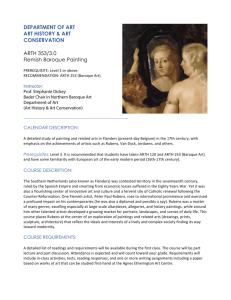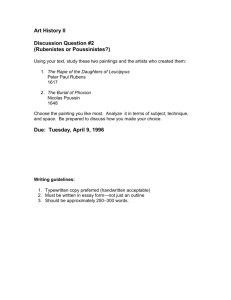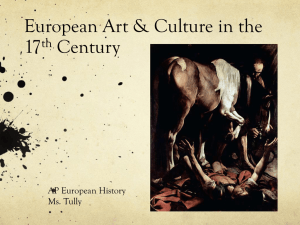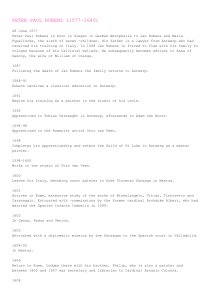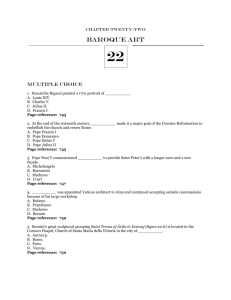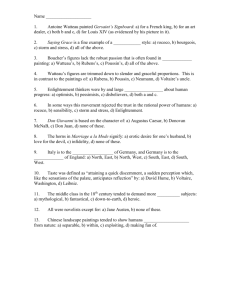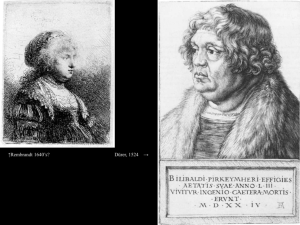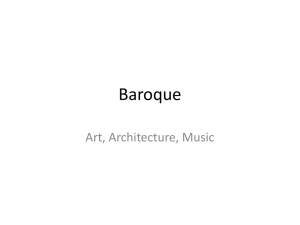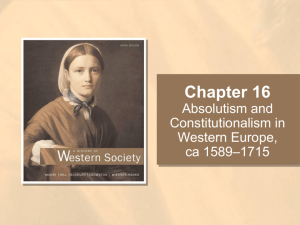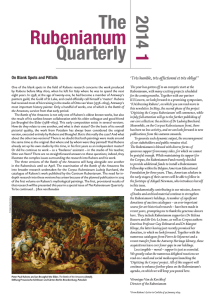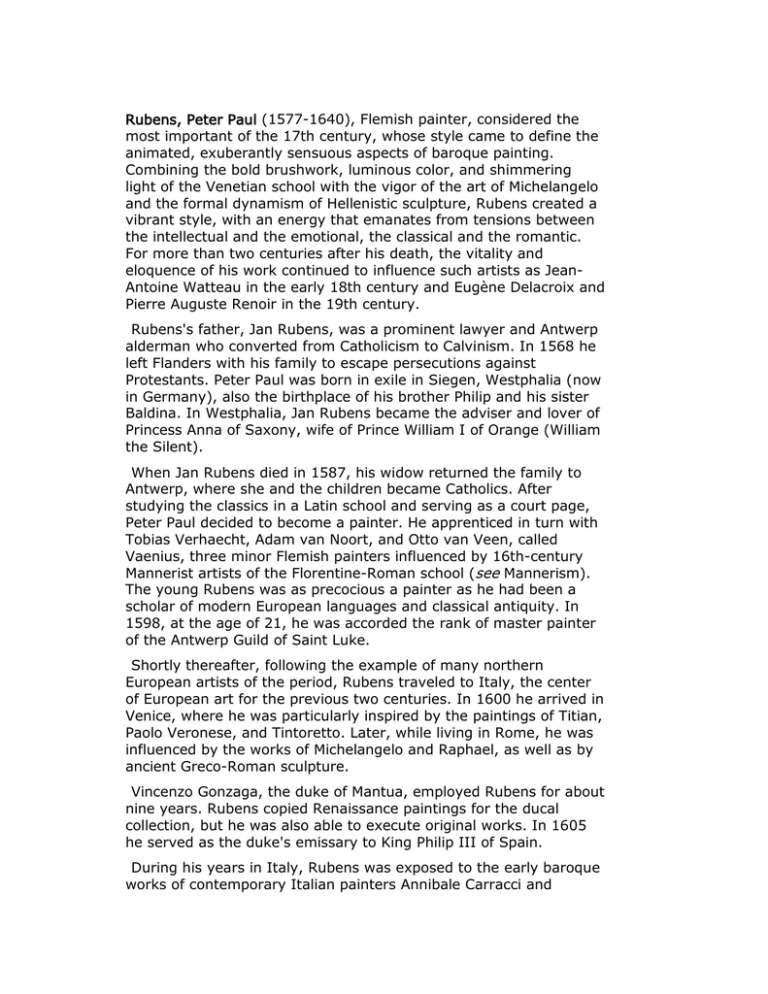
Rubens, Peter Paul (1577-1640), Flemish painter, considered the
most important of the 17th century, whose style came to define the
animated, exuberantly sensuous aspects of baroque painting.
Combining the bold brushwork, luminous color, and shimmering
light of the Venetian school with the vigor of the art of Michelangelo
and the formal dynamism of Hellenistic sculpture, Rubens created a
vibrant style, with an energy that emanates from tensions between
the intellectual and the emotional, the classical and the romantic.
For more than two centuries after his death, the vitality and
eloquence of his work continued to influence such artists as JeanAntoine Watteau in the early 18th century and Eugène Delacroix and
Pierre Auguste Renoir in the 19th century.
Rubens's father, Jan Rubens, was a prominent lawyer and Antwerp
alderman who converted from Catholicism to Calvinism. In 1568 he
left Flanders with his family to escape persecutions against
Protestants. Peter Paul was born in exile in Siegen, Westphalia (now
in Germany), also the birthplace of his brother Philip and his sister
Baldina. In Westphalia, Jan Rubens became the adviser and lover of
Princess Anna of Saxony, wife of Prince William I of Orange (William
the Silent).
When Jan Rubens died in 1587, his widow returned the family to
Antwerp, where she and the children became Catholics. After
studying the classics in a Latin school and serving as a court page,
Peter Paul decided to become a painter. He apprenticed in turn with
Tobias Verhaecht, Adam van Noort, and Otto van Veen, called
Vaenius, three minor Flemish painters influenced by 16th-century
Mannerist artists of the Florentine-Roman school (see Mannerism).
The young Rubens was as precocious a painter as he had been a
scholar of modern European languages and classical antiquity. In
1598, at the age of 21, he was accorded the rank of master painter
of the Antwerp Guild of Saint Luke.
Shortly thereafter, following the example of many northern
European artists of the period, Rubens traveled to Italy, the center
of European art for the previous two centuries. In 1600 he arrived in
Venice, where he was particularly inspired by the paintings of Titian,
Paolo Veronese, and Tintoretto. Later, while living in Rome, he was
influenced by the works of Michelangelo and Raphael, as well as by
ancient Greco-Roman sculpture.
Vincenzo Gonzaga, the duke of Mantua, employed Rubens for about
nine years. Rubens copied Renaissance paintings for the ducal
collection, but he was also able to execute original works. In 1605
he served as the duke's emissary to King Philip III of Spain.
During his years in Italy, Rubens was exposed to the early baroque
works of contemporary Italian painters Annibale Carracci and
Caravaggio, and he associated with some of the leading humanist
intellectuals of the day. Gradually, the bourgeois Flemish painter
became a gentleman artist of international repute.
It was news of his mother's impending death that brought Rubens
back to Antwerp in 1608. Although he did not arrive in time to see
his mother alive, he remained in Antwerp, where he married Isabella
Brant the following year. While in Italy, Rubens had formulated one
of the first innovative expressions of the baroque style, which on his
return earned him recognition as the foremost painter of Flanders.
He was immediately employed by the burgomaster of Antwerp. His
success was further confirmed in 1609, when he was engaged as
court painter to the Austrian archduke Albert and his wife, the
Spanish infanta Isabella, who together ruled the Low Countries as
viceroys for the king of Spain. The number of pictures requested
from Rubens was so large that he established an enormous
workshop, in which he would execute the initial sketch and final
touches while his apprentices completed all the intermediary steps.
In addition to receiving court commissions from Brussels and
abroad, the highly devout Rubens was much in demand by the
militant Counter Reformation church of Flanders, which regarded his
dramatic, emotionally charged interpretations of religious events—
such as the Triptych of the Raising of the Cross (1610-1611,
Antwerp Cathedral)—as effective instruments for spiritual
recruitment and renewal. Prosperity allowed Rubens to build an
Italianate residence in Antwerp, where he housed his extensive
collection of art and antiquities.
Between 1622 and 1630 Rubens's role as a diplomat was equal to
his importance as a painter. In 1622 he visited Paris, where the
French queen Marie de Médicis commissioned him, for the
Luxembourg Palace, to depict her life in a series of allegorical
paintings, which he completed in 1625. Despite the keen loss
Rubens felt after the death of his wife in 1626, he continued to be
highly productive. In 1628 he was sent by the Flemish viceroys to
Spain.
While in Madrid, he received several commissions from King Philip
IV of Spain, who made him secretary of his Privy Council. Rubens
also served as a mentor to the young Spanish painter Diego
Velázquez. After a delicate diplomatic mission to London in 1629,
Rubens was knighted by a grateful King Charles I of England, for
whom he executed several paintings, as well as the preliminary
sketches (finished in Antwerp, 1636) for the ceiling mural in the
Whitehall Palace Banqueting Hall.
From 1630, when he married Hélène Fourment, until his death,
Rubens remained in Antwerp, primarily at Castle Steen, his country
residence. During the final decade of his life, he continued to
execute commissions for the Habsburg monarchs of Austria and
Spain. Increasingly, he also painted pictures of personal interest,
especially of his wife and children and of the Flemish countryside.
The concerns of Rubens's late style, and indeed of his whole career,
are summarized in The Judgment of Paris (1635?, National Gallery,
London). In this painting, the richness of creation is symbolized by
the voluptuous goddesses and the verdant landscape against which
they pose. Luxuriant color, glowing light and shade, sensuous
brushwork, and an elegant composition all serve to further the
meaning of the narrative: Paris's selection of the most beautiful
goddess.
Contributed By:
Robert J. Loescher
1
1"Rubens, Peter Paul."Microsoft® Encarta® Encyclopedia 2001. © 1993-2000
Microsoft Corporation. All rights reserved.

